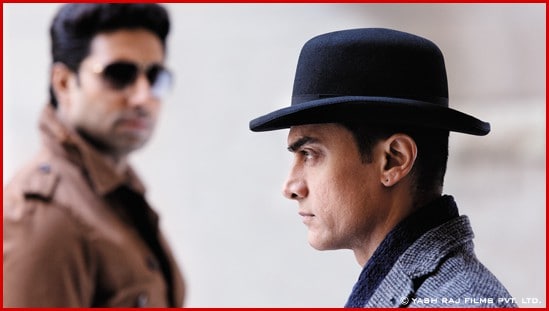The third instalment of the spirited ‘Dhoom’ franchise that hit the box office this Friday delivers the audience three hours of highs and lows. The movie bumps across its peaks and valleys courtesy the amazing performances, electrifying action and beautiful locations. Not to forget, the movie seriously defies logic and consists of songs where leads dance halting the story and portions of no significance.
The Plot
The movie is about a circus magician and acrobat Sahir (Aamir Khan) and his mission to ring the financial death knell for the Western Bank of Chicago and its director Mr. Anderson (the most expressionless foreigner ever). All this, to seemingly avenge the suicide of his father (Jacky Shroff) due to the bank’s bid to shut off their ‘Great Indian Circus’ to indemnify itself against the loss due to former’s inability to pay back the loans.
What follows is a series of action sequences where the protagonists summersault on bikes, drive autos down the slum roofs, and jump down the sky scrapers. The bikes run on ropes, they float; jump, fly and what not till the final faceoff wherein the ‘chor-police’ chase ends in an unexpected manner. Unlike common parlance, your heart races, quite confused, as you can’t decide if you really support the police or want the thief to escape.
The Positives
Aamir Khan is what you call the USP of the movie, ‘Mister Perfectionist’ as he is; he has acted meticulously pulling off the role well, sporting an amazing body and showcasing expertise on the acrobatic ropes along with his co-star Alia ( Katrina Kaif). Both of the leads have mastered the art well. The sets are grand, the wardrobe appealing and being directed by Vijay Krishna Acharya, a Kirori Mal (DU) alumnus and screenplay, dialogue and Story writer of previous Dhooms, the movie is well shot without any compromises on detailing.
The choreography is wonderful, special reference to the energetic tap dance movie begins with.
The Neutrals
Abhishek Bachchan in his shades and leather jackets and the tapori Uday Chopra have nothing new for audience to see. They are called to Chicago to catch Aamir, for the Chicago forces and SWAT teams aren’t able to, maybe. The music isn’t music to your ears, as you hardly come out of the hall humming any.
The Negatives
The movie is alarmingly lengthy with portions of no significance added to give screen time to other actors as the camera hardly spares Aamir who hogs for all the limelight. Also this movie unlike others, doesn’t show the theft happening, and emphasises more on chases that disappoints audiences. The currency notes fly in sky, and chase begins. (Really!)
And like I said, it defies logics and science.








